
|
The world of non-commercial film and A-V |
Events Diary | Search | ||
| The Film and Video Institute | | ||||
The making of Enigma
To BIAFF 2010 results | To Full Making Of Index
At BIAFF 2010 Clive Atkins won a 5-Star Award with
Enigma.
During World War II, British and American codebreakers - notably eccentric mathematician Alan Turin - working at Bletchley Park were able, following pioneering Polish work, to build a machine called Bombe to decrypt a vast number of messages which had been enciphered using the Enigma coding engine. The intelligence gleaned from this source, codenamed ULTRA by the British, was a substantial aid to the Allied war effort. |
Researching and Planning our film of Enigma
The initial research for Enigma came from several different sources starting with three well known books:
|
|
 |
Also helpful were the excellent brochures
Its website contains a wealth of information
The initial script ideas were dictated over |
Britain's Best Kept Secret |
Enigma |
Station X |
Commentary
The recording set up for the voice-over had a pop shield in front of a Shure close proximity microphone which also had a wind gag. It was plugged into a mixer leading to a Sony mini-disc recorder. Hazel Evans our narrator is a member of a local theatre group. Her script was carefully prepared to ensure that no sentence carried over from one page to the next. That avoided rustling on the recording. After a two hour recording session we end up with the finished tracks.
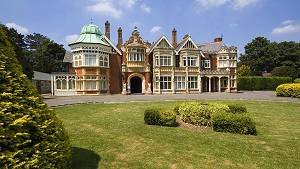 Shot 1 and ... would you believe it ... there was scaffolding
over part of the building. With judicious framing we got round that problem. Shot 1 and ... would you believe it ... there was scaffolding
over part of the building. With judicious framing we got round that problem.
In a detailed documentary preparing a shooting script before filming helps to ensure that no significant scenes are missed. Even so, it is wise to take advantage of any cutaway shots which may be useful. We chose our camera positions carefully to make the most of the shooting opportunities. There were some unlikely shots: bike racks - because one of the bikes was used to illustrate an Alan Turin story. A gas mask travelled 150 miles round trip for a 7 second shot. Another Turin story was about chaining his tea mug to the radiator. Our next stop was Hut 8 where, to our surprise, we discovered the radiator and the mug, carefully set up for us to film. We had another lucky find - a collection of old radios, which was just the thing to use over Chamberlain's speech. Luckily we were there on a quiet day and had plenty of time and space to set up our shots. We found examples of the Bombe machines in several locations all of which we filmed to give us maximum choice. |
|
Movie Trickery
Our local church hall - after the props were installed - became Bletchley Park's Hut 8. We arranged to be there an hour before the cast were due. Our cars were absolutely full of props which included 4 old black phones borrowed from a local theatre, 4 typewriters, old maps, 4 wire in-trays, 4 desk lamps, piles of paper, several books and plenty of folders. Between us we also brought 3 cameras, tripods, a steady-cam, black-out material, additional lighting and a large box of cables. When everything was ready the camera positions were established and we were all set to shoot. Each actor was shown exactly what to do and several rehearsals of each shot were tried. The steady-cam shot was tricky. I had to pull Rob back by his trousers! In the final edit this shot was slowed to half speed for better effect. |
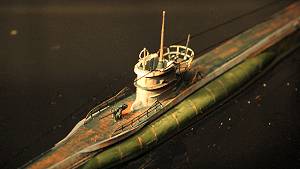 Hall's Garden Centre, our local Nursery, kindly loaned us a
black garden pond for the sub-marine shoot, they even delivered it for me
... a sort of ocean in a box one might say. In order to make the submarine
sink our model maker, Andy Lound, drilled several holes in the hull. The
camera was set up on a low tripod and the pond was filled using my garden
hose. The only direct light was a torch to simulate the destroyer's search-light.
We started off with the submarine attached to a pole but this proved unsuccessful
and we finished up with Andy controlling it by hand. We recorded several
takes with the torch travelling along the hull at different speeds. Hall's Garden Centre, our local Nursery, kindly loaned us a
black garden pond for the sub-marine shoot, they even delivered it for me
... a sort of ocean in a box one might say. In order to make the submarine
sink our model maker, Andy Lound, drilled several holes in the hull. The
camera was set up on a low tripod and the pond was filled using my garden
hose. The only direct light was a torch to simulate the destroyer's search-light.
We started off with the submarine attached to a pole but this proved unsuccessful
and we finished up with Andy controlling it by hand. We recorded several
takes with the torch travelling along the hull at different speeds.
After 2 hours we reviewed all the takes and decided we had enough material for the planned scenes. No less than 6 layers of sound tracks were added to get the final result. Our nearest steam railway is at a local beauty spot near Brownhills. Once again my IAC card proved useful. Unfortunately trains only depart every 2 hours so to record more than one take was a lengthy business. Despite various historical references, there were no geese on the lake at Bletchley on any of our visits, so we tried filming them in my local park. The problem with geese is as soon as you get a decent group of them they all swim away in different directions. Another problem with the park lake was that there was no view of the Mansion so with a little Photoshop trickery it was made to replace the park huts. |
One scene was recreating the typing of the War Office letter. This proved quite difficult because the camera had to be set up between the typist and the keyboard. The letterhead was recreated in Photoshop based on a sample found on the internet. Photoshop proved useful once again to scan a crossword from a book and surround it by authentic adverts taken from a wartime newspaper bought at an antique fair. The code book was created by covering the front of a small notebook with a replica of the German eagle insignia.
- Clive Atkins
In an interesting approach Clive worked with Richard Brown to produce an AV sequence on the same subject using a very similar script and the same interviews. And Never Cackled took part in the IAC Geoffrey Round International AV Competition and was received to popular acclaim at BIAFF 2010.
Share your passions.

Share your stories.
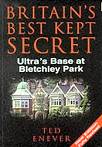

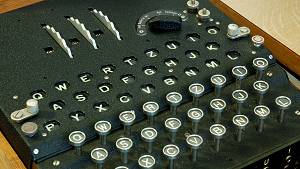 Shooting
Shooting
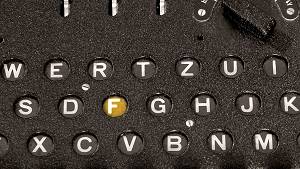 To save our actress, Margarete, the 150 mile round trip to
Bletchley, we shot some scenes in the grounds of a local stately home. Our
actress was briefed and had several rehearsals before a take was attempted.
This was to be the final shot of the scene where Margarete pretends to see
the Mansion again after more than 50 years. Plenty of time was needed for
the opening shot to allow the Enigma caption to appear over it one letter
at a time. There were magnificent wrought iron gates, but unfortunately the
gate stop was too high to allow a car to drive over.
To save our actress, Margarete, the 150 mile round trip to
Bletchley, we shot some scenes in the grounds of a local stately home. Our
actress was briefed and had several rehearsals before a take was attempted.
This was to be the final shot of the scene where Margarete pretends to see
the Mansion again after more than 50 years. Plenty of time was needed for
the opening shot to allow the Enigma caption to appear over it one letter
at a time. There were magnificent wrought iron gates, but unfortunately the
gate stop was too high to allow a car to drive over.